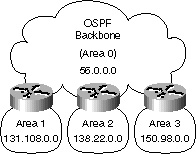The Fundamentals of OSPF Routing Design
Scenario 1: Assigning Unique Network Numbers to Each OSPF Area In this scenario each OSPF area has its own unique NIC-assigned IP address range. This can be as grand as a Class A address for the entire network with multiple Class Bs assigned to each area, or more realistically, you can be using a group of Class C addresses. This example is demonstrated in Figure 5-15. The benefits of this method are as follows:
The following two steps are the basic steps for creating such a network:
As an example, the route summarization configuration at the ABRs is greatly simplified. Routes from area 4 injected into the backbone would be summarized as “all routes starting with 150.98 are found in area 4.” This can be accomplished on a Cisco router with the following command: area 4 range 150.98.0.0 255.255.0.0 The main drawback of this approach is that it can be very wasteful with important IP address space. Of course, this space could also be very difficult to obtain, at least until IPv6. Scenario 2: Complex Address Assignment with Only a Single NIC Address There might be a situation where you only have one NIC address (a single Class B for example) to allocate for all areas of your multi-area OSPF network. You might also wish to save some address space by using VLSM such that the point-to-point serial links in each area have a subnet mask that allows two hosts per subnet. This example uses part of the address space for the NIC address 150.100.0.0. It is meant to illustrate both the concept of “area masks” and also the breakdown of large subnets into smaller ones (VLSMs). The points that follow list the assumptions made and describe the process used to allocate addresses:
The portion of the address space that has the 2-bit host field (subnet mask of 255.255.255.252) was chosen arbitrarily from one of the larger subnet fields. This method of assigning addresses for the VLSM portion of the address space is done to guarantee no address overlap. Alternatively, if the requirement had been different, you could have chosen any number of the larger subnets (with mask 255.255.255.240) and broken them up into smaller ranges with fewer hosts, or combined several of them to create subnets with more hosts. Realistic Summarization Design Guidelines It is important to note that the sample of addresses and mask boundary choices in scenario 2 were chosen simply so that the entire address space of a single area could be shown on a single page. It is not realistic to have an OSPF network designed with 500 areas. A realistic design might include the following:
Real World Route Summarization Example Now that you know about segmenting the IP address space for 500 areas, you can take a more realistic approach. Assume that you have the following design criteria and IP addresses to work with:
Area Assignment Here, each Class C network will be used entirely in its own area (similar to scenario 1) and the Class B address will be subdivided using an area mask and distributed among the remaining 16 areas. The Class B network, 156.77.0.0, could be subdivided as follows: 156.77. x x x x y y y y . y z area mask boundary The letters x, y and z represent bits of the last two octets of the Class B. The four x bits are used to identify 16 areas. The five y bits represent up to 32 subnets per area. The seven z bits allow for 126 (128-2) hosts per subnet. All of the principles used for summarization and VLSM shown in scenarios 1 and 2 also apply for this more realistic example. Route summarization is extremely desirable for a reliable and scalable OSPF internetwork. The effectiveness of route summarization, and your OSPF implementation in general, hinges on the addressing scheme that you adopt. Summarization in an OSPF internetwork occurs between each area and the backbone area. Summarization must be configured manually in OSPF.
|
EAN: 2147483647
Pages: 200
- Chapter I e-Search: A Conceptual Framework of Online Consumer Behavior
- Chapter IV How Consumers Think About Interactive Aspects of Web Advertising
- Chapter V Consumer Complaint Behavior in the Online Environment
- Chapter IX Extrinsic Plus Intrinsic Human Factors Influencing the Web Usage
- Chapter XVI Turning Web Surfers into Loyal Customers: Cognitive Lock-In Through Interface Design and Web Site Usability

